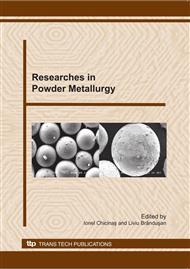p.183
p.187
p.191
p.195
p.203
p.207
p.215
p.219
p.223
Chemical Reactions during Sintering of Mn and Mn-Cr Prealloyed Steels in Inert versus Reducing Atmospheres
Abstract:
In this work the reduction during sintering of Mn and/or Cr prealloyed steels has been studied. In inert atmospheres, the reduction of surface and especially of internal oxides in these steels is shifted to markedly higher temperatures than in Fe-C or conventionally alloyed PM steel grades, reduction being not yet completed at 1300°C. At least at higher alloy element contents, the main reduction starts about 1000°C compared to 700°C for Fe-C, in both cases removal of surface oxides being the first major process. Sintering in high purity H2 results in partial reduction in the 400°C range, H2O being formed as the product, but removal of the remaining oxides requires more or less the same high temperatures as in inert atmospheres, and the reaction product is mainly CO, which confirms that at temperatures >1000°C carbon is the reducing agent in any sintering atmosphere.
Info:
Periodical:
Pages:
203-206
Citation:
Online since:
January 2011
Keywords:
Price:
Сopyright:
© 2011 Trans Tech Publications Ltd. All Rights Reserved
Share:
Citation:


